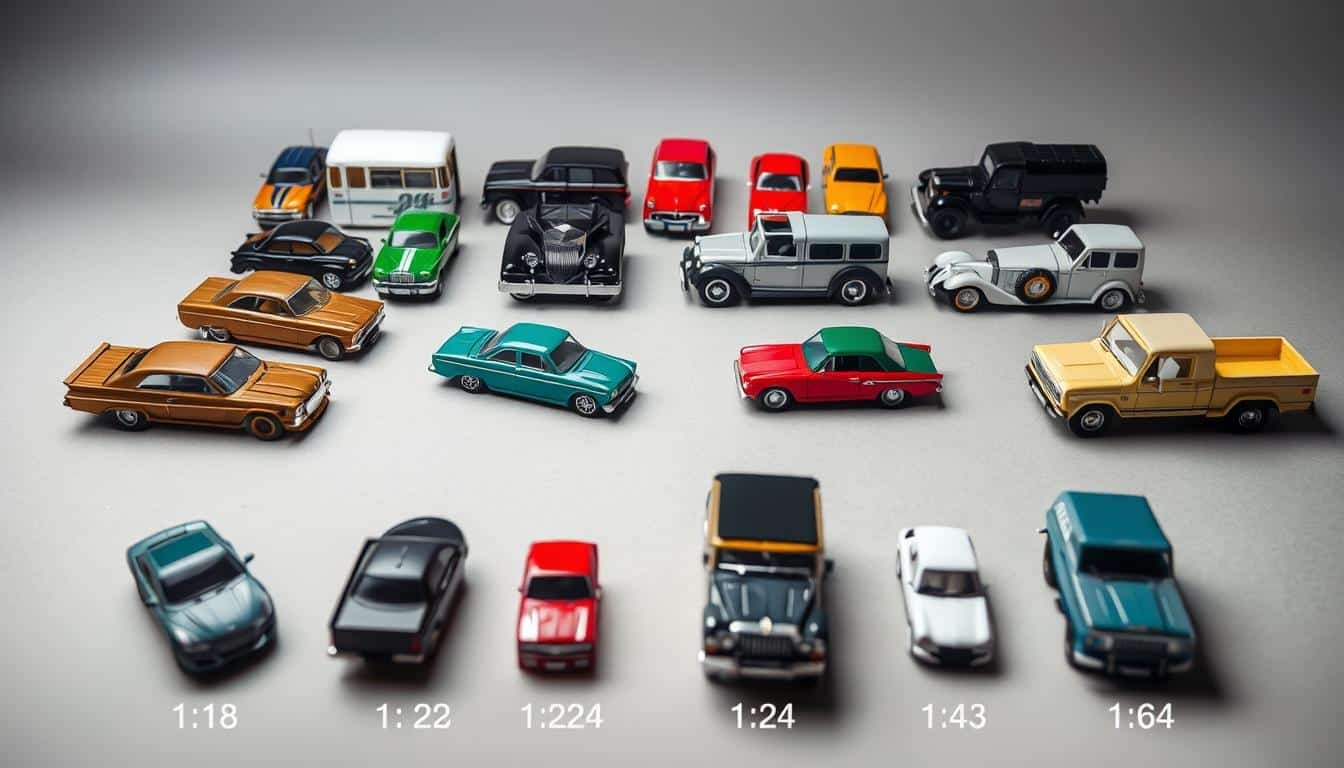A 1:12 scale diecast model of a 4.3-meter car is about 24 cm long. This fact shows how diecast model scales create mini versions of our favorite vehicles.
Diecast model scales let us explore car history and design in miniature. They range from detailed 1:12 models to tiny 1:64 “Hot Wheels” toys. Each scale ratio has its own unique features and uses.
This guide helps both new and experienced collectors understand diecast model sizes. We’ll look at how different scales work and their popular uses. We’ll also see how they compare to the real vehicles they represent.
Key Takeaways
- Diecast model scales range from 1:12 (largest) to 1:76 (smallest) for cars
- Scale ratios indicate how many times smaller the model is compared to the original vehicle
- 1:43 scale is known as the “Collector’s Size” and averages 11 cm in length
- 1:18 scale models are popular for luxury sports and vintage cars
- 1:64 scale, or “Hot Wheels” size, is ideal for large collections in limited spaces
How Do Diecast Scales Work
Diecast scales create miniature vehicle models that mirror real-life cars. These scales set the size relationship between the model and its full-sized counterpart. They ensure accurate proportions in miniature replicas.
Understanding Scale Ratios and Measurements
Scale ratios show how much smaller a model is than the original vehicle. A 1:18 scale model is 18 times smaller than the real car. This system allows for consistent scaling across different vehicle types.
Relationship Between Model Size and Original Vehicle
The chosen scale directly affects the model’s size. Smaller scales produce tinier models, while larger scales create bigger replicas. Here’s a breakdown of popular scales and their typical lengths:
| Scale | Approximate Length | Popularity |
|---|---|---|
| 1:64 | 7.5 cm | Common for small collectibles |
| 1:43 | 10 cm | Most prized among collectors |
| 1:24 | 17 cm | Popular in the United States |
| 1:18 | 25 cm | Offers good detail and size balance |
| 1:12 | 35 cm | Less common, limited choices |
| 1:8 | 60 cm | Largest scale, highly detailed |
Scale Expression Methods: Fractions vs Ratios
Scales can be shown as fractions (1/18) or ratios (1:18). Both mean the same in diecast manufacturing. Manufacturers choose based on preference or industry standards for collectible model specs.
Grasping scale concepts is key for collectors and enthusiasts. It helps them appreciate diecast model details. This knowledge also aids in making smart choices when building collections.
Popular Diecast Model Scales and Their Applications

Diecast model sizes vary widely, catering to different collector preferences. Scale ratios determine the detail level and practical applications of these miniature vehicles. These factors shape the collector’s experience.
The 1:18 scale is a favorite among car enthusiasts. It offers excellent detail while remaining manageable in size. This scale strikes a balance between realism and practicality.
The 1:43 scale provides a good balance for those with limited space. It’s compatible with O gauge model railways. This scale offers versatility for various collecting styles.
Hot Wheels and Matchbox cars typically fall into the 1:64 scale. This size is perfect for extensive collections in compact areas. It allows collectors to amass large numbers of models.
Specialized scales exist for specific vehicle types. Tractors and agricultural vehicles often come in 1:32 scale. Trucks and construction equipment are commonly found in 1:50 scale.
Military vehicle enthusiasts might prefer the 1:72 scale. This scale is widely used for both vehicles and aircraft models. It allows for diverse military collections.
“The choice of scale depends on factors like display space, level of detail desired, and compatibility with other models or dioramas.”
When selecting a scale for your collection, consider these factors:
- Available display space
- Desired level of detail
- Compatibility with existing models
- Specific vehicle types of interest
Understanding model vehicle measurements is key to making informed decisions. It helps collectors choose the right scale for their needs. This knowledge enhances the collecting experience.
Here’s a comparison of popular scales:
| Scale | Typical Use | Approx. Size (12″ original) |
|---|---|---|
| 1:18 | Detailed car models | 8 inches |
| 1:43 | General collecting | 3.5 inches |
| 1:64 | Hot Wheels, Matchbox | 2.25 inches |
| 1:72 | Military vehicles | 2 inches |
Understanding these scales helps you plan your collection effectively. You can ensure your diecast models fit perfectly within your hobby space. This knowledge enhances your collecting experience.
Conclusion
Diecast model scales offer a captivating world for hobby lovers. Understanding scale ratios and collectible model specifications helps make smart choices. The most common scales are 1:18, 1:24, 1:43, and 1:64.
Larger scales like 1:18 show fine details and moving parts. They’re perfect for displaying special pieces. The 1:43 scale balances detail and practicality, making it popular among collectors.
Some models, especially rare or historic cars, may increase in value over time. Proper care is crucial for your collection. Clean models with a soft cloth and keep them away from sunlight and moisture.
Display cases shield your treasures from dust and damage. They keep your models beautiful for years. The diecast world offers endless options for car art lovers.
FAQ
What is diecast scale?
How do diecast scales work?
What are the most popular diecast model scales?
How do I choose the right diecast model scale?
Are there specialized scales for different types of vehicles?
What’s the difference between fraction and ratio expressions in diecast scales?
How does scale affect the level of detail in diecast models?
What is the largest commonly available diecast scale?
How do diecast scales impact collectibility?
Can diecast models of different scales be displayed together?
Source Links
- No title found – https://www.carmodels.com.au/blogs/news/15950-diecast-model-scales-explained
- Scales & Sizes – https://diecastmodelcentre.co.uk/pages/size-guide?srsltid=AfmBOooiAF25m8H6l0xQJiPK_V1kiWyLevzG5iSbbteP3QfWGzfRWZxO
- Model car scales, the guide – https://www.anmodelcars.com/en/blog/model-car-scales-the-guide-b16.html?srsltid=AfmBOoqLbLV4HHLCEA8cuq7mgwG6C0kcl7NfqYeSaF8NN3Fz3ZgsvipY
- Sizes By Scale 1:64 Scale – https://www.abovetoys.com.au/sizes/by-scale/1-64-scale/
- Sizes By Scale 1:24 Scale – https://www.abovetoys.com.au/sizes/by-scale/1-24-scale/
- CARS, SCALES AND WARGAMES – https://fearofthedarkskirmishwargame.blogspot.com/2021/03/cars-scales-and-wargames-terrain-and.html
- modeling scales guide – Betovi-Co – https://betovi-co.com/modeling-scales-guide/
- Dinky Toys scales in images – https://www.planetdiecast.com/index.php?option=com_kunena&func=view&catid=125&id=68708&Itemid=0
- The World of Diecast Models: Everything You Need to Know – https://revoltiv.com/blogs/news/the-world-of-diecast-models-everything-you-need-to-know?srsltid=AfmBOor2t40h_SA4qZfXhdd0Uzm4b9lIh0Oc221IwQW5rWuBb-aQxBHH
- Understanding the World of 1:43 Scale Models – https://www.model-car-world.co.uk/blog/post/Understanding the World of 1:43 Scale Models








Interesting read! But dont you think a visual size comparison chart would make understanding diecast scales much easier for newbies?
Really, arent diecast models just glorified toys? How can understanding scale ratios enhance our appreciation of them?
Toys for some, art to others. Understanding scale ratios deepens appreciation, just like knowing music notes.
Interesting read! But wouldnt the weight of the diecast model, not just size, affect the accuracy of the scale ratio?